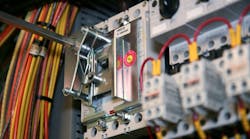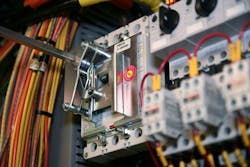Just about every product and machine we come in contact with uses electricity. To keep us safe, almost all of them have built-in safety features, especially those on the factory floor. Technicians, maintenance crews, supervisors and managers must be protected from injury due to moving parts, high temperatures, shocks and other electricity-related hazards.
Designers have a host of methods to address electrical safety issues.
When it comes to industrial electrical safety, the best offense can be a good defense. In other words, if there were a way to keep people away from dangerous electrical equipment, it would lower the chances of anyone getting hurt. One simple way to do this is to keep risky equipment secure in an enclosure. Enclosures prevent injuries, along with inadvertent tampering and vandalism.
Most automated and factory equipment requires electrical enclosures, sometimes called control enclosures. They keep moisture, dust and contaminants away from electrical and automation components. They also keep workers from getting too close to electrical components. Enclosures are best located so they do not impede traffic and aren’t in crowded areas.
Eventually, someone will need to get inside the enclosure. That could be maintenance technicians making annual checks and upgrades or inspectors looking things over. So, inside the enclosure, engineers should choose components and assemblies with guards, shields and other devices to stop visitors from touching energized components. Components should be laid out so there’s enough working room and adequate airflow. Wires should be neatly routed using wire ducts so that wires and workers are protected.
On equipment itself with moving parts, hot surfaces, or other physical hazards, the best approach providing physical barriers or guards to contain those hazards. Of course, any guard can be defeated by removal, so plant managers should also use non-contact or interlock safety switches that make it difficult to bypass. And if the guard is moved, sensors detect it and automatically have the equipment stopped and/or de-energized.
Some guards and panels must be easily movable to accommodate cleaning and replacing parts. In these cases, trapped-key interlock safety switches hold the door closed with a mechanical lock-and-key until the equipment stops and is safe to access.
Another way to physically safeguard electrical and automated equipment adds devices such as light curtains, mats, edges and bumpers. These can all be arranged around potentially dangerous equipment to detect someone approaching and stop equipment operation before the operator gets too close to the hazard.
The electrical design inside enclosures should also be safe in terms of power distribution and control circuitry. It must follow NFPA 70 National Electrical Code (NEC), which is the benchmark for safe electrical design and installation practices to protect people and property from electrical hazards. Provision and sizing of disconnect switches, overcurrent devices, conductors and associated components are all covered by the NEC.
Disconnect switches are primary electrical safety devices that isolate downstream electrical systems from upstream power. They are used in electrical switchgear, panelboards and control panels, as well as for mounting close to power-using machines such as motors. Disconnect switches can be locked open by users to ensure downstream equipment is electrically safe for maintenance or repair.
In power distribution and control panels, overcurrent devices such as circuit breakers fuses, and motor overload devices, protect downstream conductors by automatically opening a circuit when there’s an overcurrent or short-circuit. This protects equipment and workers from fault conditions.
Surge protection is another electrical safety provision and has recently received increased attention, especially since the 2017 revision of NEC section 670.6. This added the requirement to have surge protection on industrial machinery safety interlock circuits. Electrical surges can be caused by failing equipment, utility problems, and lightning strikes, and can damage operational equipment and control circuits. Surge protective devices on safety interlock circuits help ensure safety functions operate continually and are protecting workers.
For motor-driven electrical equipment, prudent designers include devices not absolutely required but proving additional protection. For instance, phase-monitoring relays detect electrical problems such as phase loss or phase imbalance, each of which can cause hazardous operating conditions. Similarly, some equipment can be equipped with vibration, temperature, and seal leak sensors. Wiring these sensors to relays or automated switches can stop equipment if a problem is detected.
In addition to safely enclosing electrical devices and installing wiring and devices per NEC, designers can take additional steps to keep workers safe. Some of these steps are mandated by standards such as ISO 13849 Safety of Machinery, while others are simply good engineering practices.
Machinery designers must also follow ISO 13849 and perform a risk assessment to identify hazards and how to safeguard against them.
Cable-pull safety switches are particularly effective safety devices because they can span large areas of equipment and those working in the area can easily actuate them. These switches get wired into safety relay modules or more advanced safety controllers, depending on the required safety level needed. When there’s no trouble, these relays and controllers let equipment operate and hold all trapped-key interlocks closed. However, if a safety sensor is triggered, the equipment is de-energized and brought to a safe state as quickly as possible.
Outside of dedicated safety circuits, designers can provide automation features to help operators efficiently and safely run equipment. These include visual and audible indicators so workers can quickly understand the operating state and condition of the equipment. Specialized indicators such as modular stack lights are a good way to provide this type of indication from a much greater distance than small control-panel lights.
Pilot devices such as switches and pushbuttons, or even human-machine interfaces (HMIs), can be combined with control wiring and programmable logic controllers (PLCs) to facilitate safe startup, operation and shutdown of equipment. Careful configuration and programming of HMIs and PLCs is essential for good equipment performance and safe and efficient operator interaction with machinery.
Incorporating sufficient safety for industrial machinery and systems is never a “one-and-done” proposition. Some safety requirements for electrical and controls are mandated by codes and standards such as the NEC and ISO. Other safety measures are based on good engineering practices and careful consideration of how workers may interact with equipment. Designers can keep safety first for electrical and automation systems by following a layered approach that evaluates changing conditions and develops designs based on a portfolio of products to address physical, electrical and automation safety concerns.
Kevin Kakascik is a technical marketing engineer at AutomationDirect.



